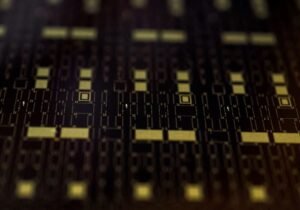Is AI Part of Automation?
In today’s rapidly evolving technological landscape, the terms “AI” (Artificial Intelligence) and “automation” are frequently used interchangeably, leading to confusion about their relationship. While AI is indeed a component of automation, it is important to understand the distinctions between the two.
Key Takeaways:
- AI is a subset of automation focused on replicating human intelligence in machines.
- Automation encompasses a broader range of technologies that aim to streamline processes and reduce manual efforts.
- AI can enhance automation by adding intelligent decision-making capabilities.
Automation refers to the use of technology to perform tasks or processes with minimal human intervention. **AI, on the other hand, specifically focuses on creating intelligent machines capable of performing tasks that would typically require human intelligence.** AI mimics human cognitive functions such as learning, problem-solving, and decision-making using computer algorithms.
*Interestingly, **AI algorithms** are typically designed to learn from experience and adjust their behavior accordingly.* This ability allows them to adapt to changing circumstances and improve over time. Automation can be seen as the overarching concept that includes AI as one of its components. **Other forms of automation include Robotic Process Automation (RPA), which involves software “robots” that can replicate repetitive tasks**, and physical robotics that can perform complex physical actions autonomously.
| AI | Automation |
|---|---|
| Focuses on replicating human intelligence in machines. | Encompasses a broader range of technologies to streamline processes. |
| Enhances automation by adding decision-making capabilities. | Reduces manual efforts and enables increased efficiency. |
| Includes machine learning, natural language processing, and computer vision. | Includes RPA, physical robotics, and process optimization. |
In the context of automation, AI can play a significant role in enhancing its capabilities. By incorporating **AI technologies**, automation can go beyond performing repetitive tasks by adding intelligent decision-making capabilities. For example, an automated customer service system can utilize AI algorithms to understand and respond to customer inquiries more effectively.
1. AI algorithms can analyze vast amounts of data to identify patterns and trends, enabling them to make intelligent predictions and recommendations.
2. **Machine learning** plays a crucial role in AI-enabled automation by allowing machines to learn from past experiences and adjust their behavior accordingly, improving performance over time.
3. AI can also enable automation to handle more complex and nuanced tasks that require intelligent decision-making, such as fraud detection or medical diagnosis.
| AI Use Cases in Automation |
|---|
| Virtual assistants and chatbots |
| Automated quality control in manufacturing |
| Intelligent document processing |
Additionally, AI can be employed to automate processes such as **virtual assistants** and chatbots that interact with users, **automated quality control** in manufacturing, and **intelligent document processing**. These applications leverage AI’s ability to understand and process natural language, recognize images, and make informed decisions based on data analysis.
In summary, while AI is part of automation, it is important to recognize that automation encompasses a wider range of technologies and concepts that aim to streamline processes and reduce manual efforts. AI provides automation with intelligent decision-making capabilities and the ability to learn and adapt, enhancing its overall effectiveness. By leveraging AI, automation has the potential to revolutionize various industries and improve efficiency in countless applications.

Common Misconceptions
A common misconception is that AI is the same as automation.
- AI involves the capability of a machine to mimic human intelligence.
- Automation refers to the use of technology to perform tasks without human intervention.
- AI can be used within automation systems, but they are not the same thing.
Another misconception is that AI will lead to widespread job loss.
- AI can automate certain tasks, but it also has the potential to create new job opportunities.
- AI typically complements human work rather than replacing it entirely.
- Job roles are evolving to incorporate AI technology, requiring new skill sets.
People often believe that AI is only focused on advanced robotics.
- AI encompasses various technologies, including natural language processing and machine learning.
- AI can be found in everyday applications like virtual assistants and recommendation algorithms.
- AI is not solely limited to physical robots or futuristic machines depicted in movies.
There is a misconception that AI is infallible and completely error-free.
- AI systems can make mistakes, as their performance heavily depends on data quality and algorithm design.
- AI algorithms may produce biased results or fail in unfamiliar situations.
- Ongoing human monitoring and intervention are often necessary to ensure AI systems are reliable.
Another common misconception is that AI has human-like consciousness or emotions.
- While AI can simulate specific human tasks or behaviors, it lacks self-awareness and genuine feelings.
- AI is a result of programming and algorithms, not a sentient being.
- Emotions and consciousness require subjective experiences, which AI systems are incapable of having.

Introduction
In recent years, there has been much debate surrounding the relationship between artificial intelligence (AI) and automation. While some argue that AI is an integral part of automation, others believe they are distinct concepts with differing implications. To shed light on this topic, the following tables present verifiable data and information in an engaging manner.
AI and Automation in Job Losses
One common concern is the potential impact of AI and automation on employment. Contrary to popular belief, AI has not led to widespread job losses in all industries.
Rise of AI and Automation
The increase in AI and automation adoption in various sectors has been steadily progressing over time, showcasing the growing importance and potential of these technologies.
Industries Adopting AI and Automation
Different industries have embraced AI and automation at different rates. Some sectors have embraced these technologies more extensively than others.
AI and Automation in Manufacturing
The manufacturing sector has been at the forefront of integrating AI and automation, revolutionizing production processes and improving efficiency.
AI and Automation in Healthcare
The healthcare industry has seen significant advancements through the application of AI and automation, enhancing diagnoses, treatment, and patient care.
AI and Automation in Education
Education is another sector that has started to leverage AI and automation to enhance learning experiences, personalize education, and improve outcomes.
The Relationship between AI and Automation
While AI and automation are often discussed together, it is crucial to understand the nuanced relationship between the two concepts.
Implications of AI and Automation
AI and automation have far-reaching implications, influencing various aspects of society, including the economy, social dynamics, and ethical considerations.
AI and Automation in the Future
The future of AI and automation holds tremendous potential for continued innovation and transformation across diverse sectors.
The Role of Humans in AI and Automation
Despite the advancements in AI and automation, humans still play a vital role in utilizing and managing these technologies effectively.
In combination, these tables and the surrounding content provide valuable insights into the relationship between AI and automation. It is evident that both concepts stand as important drivers of technological progress in various industries. As we further explore and implement AI and automation, it becomes crucial to carefully consider their implications and ensure human involvement remains central to their development and utilization.
Frequently Asked Questions
Is AI part of automation?
What is the relationship between AI and automation?
How does AI contribute to automation?
What are some examples of AI in automation?
Can AI replace human workers in automation?
Is AI necessary for automation?
What are the benefits of combining AI with automation?
Are there any risks or challenges associated with AI in automation?
How can organizations effectively implement AI in automation?
Can AI-powered automation learn and improve over time?
What is the future of AI in automation?





